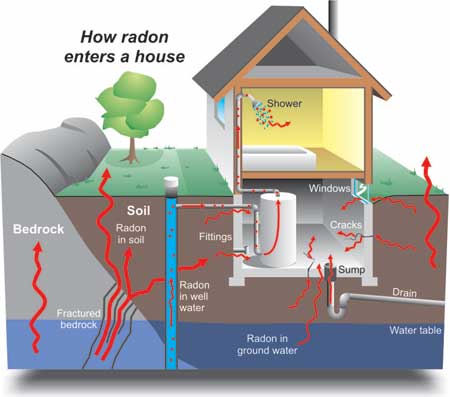Massachusetts Home Inspections YOUR INVESTMENT IS MY CONCERN

Radon In Your Home

Most indoor radon enters a building from the soil or rock beneath it. As radon and other gases rise through the ground, they can become trapped beneath the structure, building up pressure. Because air pressure inside homes is typically lower than the pressure in the soil, this difference forces gases through cracks and openings in floors and walls. Once inside, radon can accumulate and become concentrated, especially in poorly ventilated areas.
Common entry points that allow radon into your home:
*Cracks in solid floors and foundations below grade
*Construction joints
*Gaps in suspended floors
*Sump pits and open floor drains
*Cavities in foundations below grading
*Gaps in floor around utility penetrations (plumbing and wiring)
*Crawl spaces that open directly into the building
*The water supply (especially well water, though this is less common than soil gas entry)
Radon can also be present in water, especially well water. When this water is used—for example, from a faucet—some of the radon is released into the air. Typically, about one ten-thousandth of the radon in water escapes into the indoor air. The higher the radon concentration in the water, the more it can contribute to indoor radon levels. Trace amounts of uranium, which produces radon as it decays, may also be found in certain construction materials such as concrete, brick, granite, and drywall. While these materials can emit radon, they are rarely the primary source of elevated indoor levels. In some cases, even outdoor air drawn into a building can slightly contribute to indoor radon concentrations.
The average radon level in outdoor air is about 0.4 picocuries per liter (pCi/L), though it can be higher in certain regions. While some geographic areas are more prone to radon issues, any home—regardless of age, construction type, ventilation, or whether it has a basement—can have elevated radon levels.
Radon levels are often higher in homes that are well-insulated, tightly sealed, or built on soil rich in uranium. Basement and first-floor areas typically have the highest radon concentrations due to their proximity to the ground. Homes located below the third floor in multifamily buildings are also particularly at risk.
Here is what my clients have to say about my home inspection services:
Press F5 (on your keyboard) for additional testimonials
Hi Dave,
I want to thank you for the home inspection you did for us at 144 Avis Ave. in Dracut MA. We did not get the house because the home owners did not want to split the cost of fixing that wall. I had gotten two estimates, one from a landscaper and one from a Mason. Both gave an estimate of $15,000.00, for which I am grateful for your inspection and pointing out the wall problem. It would of been an undue burden on us, not to mention I am also grateful about the radon testing also. I just got the results today and they came back at 7.5 and 8.4, so that would of been another expense. I do hope that when we find a new house that you will be able to do our home inspection. Your fee was a drop in the hat, to what it would of cost us to fix the wall and then the cost of venting the basement. My husband was also very impressed with your report and how well it was written. Just wanted to drop you a line to let you know what happened, and hopefully will be doing business with you again very soon.
Have a Good Day
Jackie Sliney














